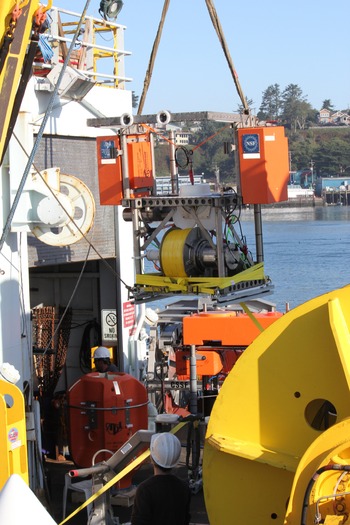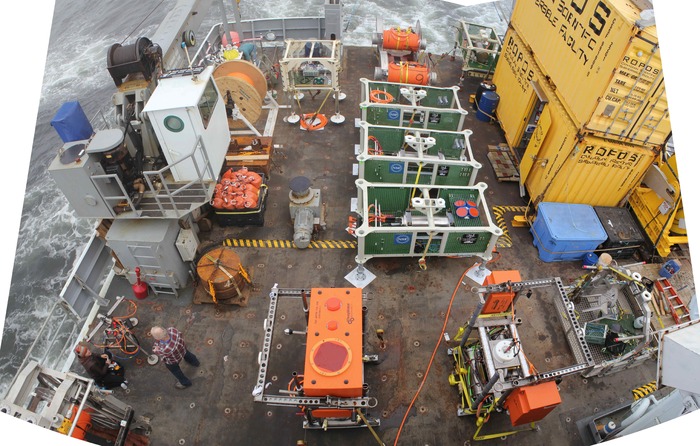
During the port call for Leg 4 in Newport, Oregon, the UW-APL-built Shallow Winched Profiler was loaded onto the R/V Thompson. The system has an underwater level wind that "spools" out yellow cable, which will provide power and communications to an attached instrument "pod" (orange bulbous-shaped package bottom left). The profiler will be located at a water depth of ~197 m on the already installed mooring at the EA Offshore Site. Several times a day the instrument pod will rise from the 197-m-deep platform to just beneath the ocean's surface making critical chemical and biological measurements. Photo Credit: Skip Denny, APL-UW; V14.
Leg 4 of the VISIONS'14 Expedition departed Newport, Oregon, today after a packed 2.5-day mobilization. The R/V Thompson is once again "loaded to the gills" with cables, junction boxes, instruments, and mooring packages to be installed at the Slope Base, Southern Hydrate Ridge, and Oregon Offshore sites. Early this morning, an instrumented shallow profiler system with an underwater winch, and a large instrumented platform were loaded onto the Thompson. These will be installed by the ROV ROPOS on a platform at 197-meter water depth on the two-legged Shallow Profiler Mooring built by the UW Applied Physics Lab. The mooring and platform were installed during Leg 3 at the EA Offshore site. This is a truly state-of-the-art system that will allow new measurements to be made of phenomena that include thin layers hosting significant biomass within the water column and measurements of zooplankton associated with digital-still images - all coming in at real time over the Internet. The data will be made available early in 2015 and announced by Ocean Leadership.
During the transit, the engineers and science team prepared for the upcoming deployment of the HPIES instrument, which measures the horizontal electric field, pressure, and various water properties that include temperature, salinity, and ocean currents. Following the HPIES deployment, ROPOS Dive R1757 at the Slope Base Site will install a 1283-m-long cable that will connect the HPIES instrument to the Low Power Junction Box (LJ01A). The junction box will provide power and communications to this instrument when it is turned on.
Onboard, there is a new group of ten undergraduate and graduate students from the UW College of the Environment, School of Oceanography, and Earth and Spaces Sciences Department, as well as from the UW College of Engineering. Today was spent getting acquainted with the ship, participating in a fire and boat drill, and learning the ROV logging system and digital-still camera acquisition system. The students began brainstorming and working on their projects. It is great to be at sea again!


